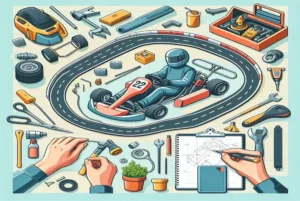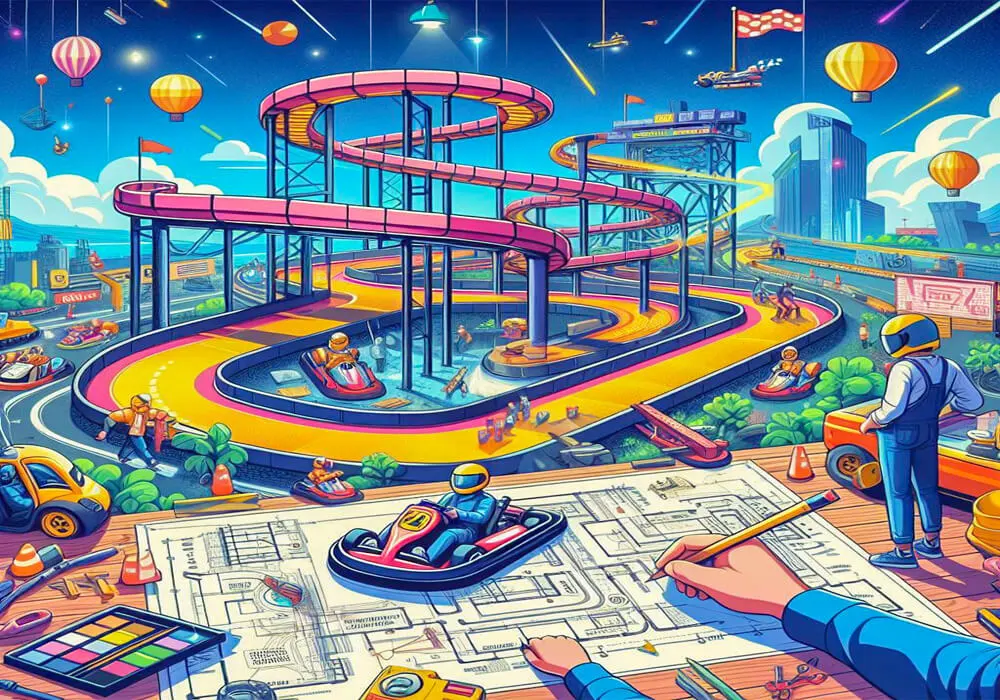How to Build Go Kart Race Track?
Building a go-kart race track is an exciting project that can provide endless entertainment and serve as a fantastic venue for events, fundraisers, or team-building exercises.
Whether you’re planning to create a temporary setup in a parking lot or a permanent installation, this guide will walk you through the essential steps to design and build a safe, fun, and engaging go-kart race track.
Go-Karting Track Needs

Before breaking ground on your go-kart track, it’s crucial to determine your specific needs and goals. Consider the following:
1. Purpose: Is the track for personal use, a community event, or a commercial venture?
2. Location: Do you have a suitable piece of land, or will you be using an existing paved area like a parking lot?
3. Budget: How much are you willing to invest in the project?
4. Safety: What measures will you take to ensure the track is safe for all participants?
Choosing the Right Location
The location of your go-kart track plays a significant role in its design and functionality. Here are some key considerations:
1. Space Requirements: Ensure you have enough space for the track layout, pit area, and spectator zones. A minimum area of 2000 square meters is recommended for a small track.
2. Ground Surface: Concrete or asphalt surfaces are ideal for go-karting, providing a smooth and durable racing experience. Dirt tracks can also be used but require more maintenance.
3. Accessibility: Choose a location that is easily accessible for participants and spectators, with ample parking and facilities.
Designing the Track Layout
The design of your go-kart track will greatly influence the driving experience. A well-thought-out layout includes:
1. Straightaways and Turns: Incorporate a mix of straight sections and various turns to challenge drivers and enhance the fun.
2. Safety Barriers: Use high-visibility barriers to outline the track and protect drivers. Plastic barricades filled with water or sand are recommended for their durability and impact resistance.
3. Pit Area: Designate a safe and accessible pit area for kart maintenance and driver preparation.
4. Spectator Zones: Plan areas for spectators to watch the races safely without obstructing the track.
Preparing the Ground
Proper ground preparation is essential for a smooth and safe track. Depending on your surface choice, follow these steps:
Dirt Track
- Clearing and Leveling: Remove grass, rocks, and debris. Level the ground to ensure a smooth surface.
- Base Layer: Lay a base layer of compacted gravel or crushed stone to improve drainage and stability.
- Top Layer: Add a top layer of fine dirt or clay, and compact it to create a firm racing surface. Regular maintenance is required to keep the track smooth.
Concrete or Asphalt Track
1. Marking the Layout: Use string, stakes, and chalk to outline the track on the ground.
2. Excavation: Excavate the marked area to a depth of about six inches.
3. Base Preparation: Add an inch of sand as a base layer and compact it.
4. Pouring Concrete/Asphalt: Pour the concrete or asphalt, smoothing it out to create an even surface. Allow it to cure completely before use.
Installing Safety Barriers
Safety is paramount in go-kart racing. Installing the right barriers will protect drivers and spectators. Consider the following options:
1. Plastic Barricades: Lightweight and durable, these barriers can be filled with water or sand for added stability. They are ideal for creating track boundaries and minimizing impact injuries.
2. Tire Walls: Stacked tires can absorb impact and are a cost-effective option for smaller tracks.
3. Guardrails: Metal guardrails provide robust protection but should be padded to reduce the risk of injury.
Adding Track Features
Enhance your go-kart track with additional features to improve safety and enjoyment:
1. Directional Arrows and Lane Markings: Use paint or adhesive strips to mark the course direction and lanes.
2. Start/Finish Line: Clearly mark the start and finish line with flags or painted lines.
3. Hazard Signs: Place signs or lights at sharp turns and hazardous areas to alert drivers.
4. Lighting: Install adequate lighting if the track will be used at night.
Ensuring Safety and Compliance
To ensure your go-kart track meets safety standards and local regulations, consider the following:
- Safety Gear: Require all drivers to wear helmets, gloves, and other protective gear.
- First Aid: Have a first aid kit and trained personnel on-site during races.
- Insurance: Obtain liability insurance to cover accidents and injuries.
- Permits: Check with local authorities for any required permits or zoning approvals.
FAQs
What is the ideal size for a go-kart track?
The ideal size depends on your space and budget, but a small track typically requires at least 2000 square meters. Larger tracks can exceed 5000 square meters.
How much does it cost to build a go-kart track?
Costs vary widely based on location, materials, and track complexity. A basic dirt track can cost a few thousand dollars, while a professional-grade concrete or asphalt track can cost upwards of $50,000.
What safety measures are necessary for a go-kart track?
Essential safety measures include high-visibility barriers, proper signage, mandatory safety gear for drivers, first aid availability, and compliance with local regulations.
Can I build a go-kart track on my property?
Yes, you can build a go-kart track on your property, but you must ensure it complies with local zoning laws and safety regulations.
Conclusion
Building a go-kart race track is a rewarding project that can provide entertainment and serve various community and commercial purposes. By carefully planning your track’s design, preparing the ground properly, installing safety features, and ensuring compliance with regulations, you can create a safe and exciting go-karting experience. Whether you’re a go-kart enthusiast or a business owner, following these steps will help you build a track that drivers and spectators will love.

